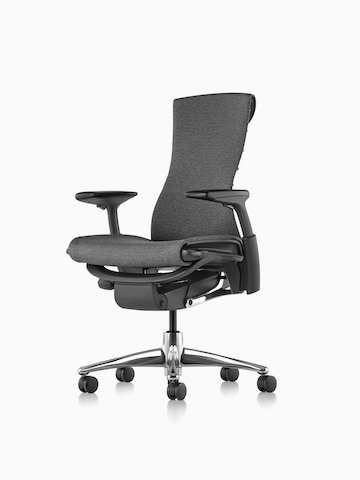Office Chair Breakdown
Here's a little brain teaser for you: Is it better to have a house built on sand or concrete?
If you guessed concrete, then a tip of the cap to you.
A concrete foundation allows the house to last longer than that of sand by providing a solid foundation for all other structures be based on. The same principle applies when it comes to having the right computer chair for the entirety of the workday and dynamic movement (if you missed our post on why ergonomics should mean something to you, check it out here)
Relevant Studies
A proper chair allows the user to sit longer with less stress on the body than a non-ergonomic chair. Here's why:
McGill reported that even after three minutes of sitting, we start to see effects on the spine, with ligamental laxity (supporting structures becoming less rigid) creeping in. When ligamental laxity occurs, the body tends to recruit muscles to help in the stability of the region. Fatigue gradually sets in, and the muscles start to spasm. While the spasms may not be noticeable, they will present as a burning or cramping sensation, most notably towards the end of the work day.
Another study performed by Amick and Robinson et al. 2003 showed how vital the chair is to desk ergonomics. Three groups were given various degrees of training, starting with a control group, replacing the current chair, and replacing their existing chair with ergonomic training.
As you might expect, the chair/training group showed the most significant amount of reported decrease in work-related pain, followed by the chair-only intervention. This study shows that even if you have minimal ergonomic knowledge, replacing your chair with a more ergonomic one can be beneficial.
I’ve come to realize that education plays a massive role in workplace injury prevention. Work with what you have but upgrade when possible.
Factors You Need To Know
Numerous components factor into a solid ergonomic chair. I believe adjustability is the #1 component. The chair should adjust to your body and allow for a comfortable prolonged sitting. The ability of the user to move dynamically within the chair is critical.
We were told at a young age that fidgeting is a no-no. Now, we know that movement and positional change is encouraged as much as possible. The body loves to move both from a physical and mental perspective. This movement allows soft tissue to contract/stretch, improves blood flow for improved mental performance, varies weight distribution contact points, and allows for joint movement on a macro and micro level.
As we know, everyone is a different shape and has differing environmental stresses placed on them. Therefore the more you can tailor the chair to you, the better.
Below are other important factors to take into consideration when choosing your next chair.
The Backrest
The back of the chair should be high enough to support the entirety of your back. It's called a backrest for a reason, hence why it should allow the whole back to rest, not just the mid-lower portions.
The back portion of the chair should also allow for 100-110 degrees of tilt. These angles ease the loading of the various structures within the lower back. Most notably, disc pressure between the vertebrae, too much pressure can lead to possible herniations and nerve impingement. Off-loading the low back muscles is important to prevent tightness and burning, which occur with prolonged forward leaning.
Finally, the lower portion of the chair should also have a built-in lumbar support or an add-on of support to preserve the gentle S-curve of our spine. Proper alignment within the spinal column allows for proper upper body weight loading on the lumbosacral region.
Seat Height
The seat should once again be as adjustable as possible to have your hips and legs at a 90-degree angle underneath you. Too low of a seat causes increased pressure on the Ischial tuberosity (the bony part of the glutes) while increasing hip flexion substantially. Too high of a seat contributes to added pressure on the posterior thigh, leading to numbness/tingling within the lower extremities.
Ideally, your feet should be flat on the floor for optimal stability. If this is not possible, a simple fix is to use a small box or footrest to provide the needed support.
Seat Length
The length of the seat should not be so long that it pushes into the back of the knees. The quick rule here is there should be 2-3 finger widths between your legs and the edge of the seat. There should also be a locking mechanism for the chair to adjust the angle but also be able to lock into place.
Armrests
Once again, the armrests should be adjustable in multiple planes of movement. The rests should be at a level where the shoulders are relaxed and not pushing the shoulders in an upward direction. This causes tightness in the shoulders and can lead to headaches if the trapezius muscles start to spasm.
My personal preference is to have the armrest lowered all the way in order for the chair to scoot under the desk. The desk then provides the necessary forearm support for computer work. The forearms should rest on the desk where they fall.
My Picks
There are few chairs I recommend that fulfill my qualifications and two companies that I recommend to everyone. Yes, they are on the expensive side, but this is an investment in your health, quality design, and materials, and it comes with 12-year warranties.
Check with your HR department to see if your company provides a stipend or employee discount for equipment. The last option is to check your local office furniture resale dealers, as you can get these chairs at a fraction of the original cost.
Herman Miller Embody
Herman Miller Aeron
Mental Changes You Need To Make
The next step is training yourself to sit in the chair properly. Buying a great chair only to sit in a terrible position, is a terrible outcome. Education is 95% of the battle when it comes to ergonomics.
The biggest misconception in the office world is that sitting perfectly erect and maintaining that posture all day is ideal. Incorrect!
The muscles will fatigue after 10-15 minutes, and you start to slouch forward slowly. Not to mention the fact that it loads the facets (joints in the spine) and disc to increased levels (see inserted pic above).
Ideally, you would sit with your butt to the back in the chair, allowing the lumbar support of the chair to promote the natural lumbar spine curve. Your back needs to rest on the backrest. Crazy concept, right?!
The ideal angle for the low back is >90 degrees and ideally 100-110 degrees.
Your feet should be flat on the floor with no dangling or stretching sensation from the chair. Also, make sure you don't have them crossed over each other. I find myself doing that every once in a while, but I self-correct it.
Posture Cogwheel Concept
Finally, I want to introduce the concept of treating posture in terms of cogwheels (because lousy posture "really grinds my gears"). When sitting, think of your head, chest, and hips as the three essential cogs.
The head should rotate back and slightly upward with the chin slightly tucked and the spine "lengthened."
The chest should rotate upward to promote the curve of the thoracic and lumbar spine.
The hips should turn down and back slightly to encourage the S-curve and push your butt to the back of the seat.
Wrap Up
I know that this was a ton of information to take in, but hopefully, it provided at least a self-check on how you should sit throughout the day. I'm not saying that you need to sit perfectly 100% of the time because we need to be realistic here.
Be aware, be educated, and keep moving!





.








